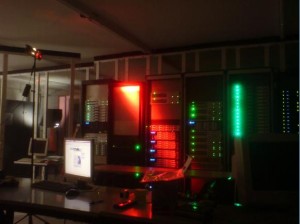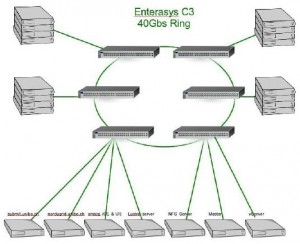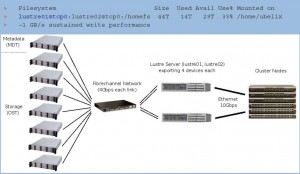HPC @ University of Bern: ubelix – Uni BErn LInuX cluster
See also the original slides of Andres Aeschlimann as pdf »
Purpose
This Grid HPC infrastructure is primarily designed to support the researchers at the Campus. They should use their time doing research and not be bothered by deploying a Grid HPC infrastructure.
Some facts
- first Linux Cluster was installed in 2001 (1 master and 32 single core nodes)
- continuously expanded to ~1000 cores in >200 nodes today
- Dual- and quadcore worker nodes
- Mostly Opterons, increasing # of Intels (Nehalem)
- several suppliers (mostly SUN, but currently also IBM and some Dell)
- < 100kW
- Gentoo Linux www.gentoo.org
- Kernel 2.6.22/2.6.27
- 2TB memory, 50TB disk
- Lustre filesystem: 1.8.1
- Sun Grid Engine 6.2
- Gb Switch
- Currently no Infiniband Switch
Internal (private) network
- TCP/IP
- Stackable Switches (~40Gbs)
- „normal“ Gigabit Ethernet on the worker nodes
- 10GE Ethernet for high throughput servers
Lustre@ubelix
Application portfolio (local users)
- HE Physics
- Astronomy
- Computational and Molecular Population Genetics Lab
- Space Research Physics
- Computer Vision and Artificial Intelligence
- Chemistry and Biochemistry
- …
Applications from remote (SMSCG)
- ATLAS: high energy physics application developed for the LHC experiment at CERN
- RSA768: cryptographic application
- NAMD and GROMACS: biochemistry applications
- GAMESS: biochemistry application (work in progress)
- …
Other clusters @ UniBE
- The LHEP UNIBE Atlas T3 2009 – A ROCKS Cluster with ~200 cores (Sun Fire X2200 IU dual quad cores) and ~50 TB on CentOS. Located in same room as ID UNIBE clusgter. Mainly serves local and remote ATLAS scientists. Backfilled with remote users and applications. Speciality: Access only via ARC clients, i.e. remote and local users habe the same interface. http://ce.lhep.unibe.ch
- Theoretical Physics (~200 cores, with interconnect)
- Climate Physics (~100 cores)
- Space Physics (~100 cores)
- Chemistry (~100 cores, with interconnect)
- Computational and Molecular Population Genetics (~60 cores)




